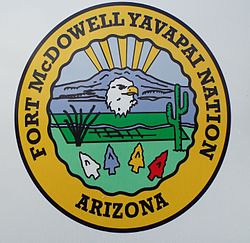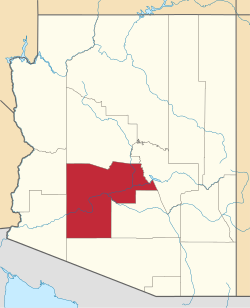Fort McDowell Yavapai Nation
The Fort McDowell Yavapai Nation (Yavapai: A'ba:ja) is a federally recognized tribe of Yavapai people. The tribe governs an Indian reservation in Maricopa County, Arizona about 23 miles (37 km) northeast of Phoenix. They have 950 enrolled citizens, with about 600 living on the reservation.[1] The tribe was formerly named the Fort McDowell Mohave-Apache Community of the Fort McDowell Indian Reservation. GovernmentThe Fort McDowell Yavapai Nation is governed by a democratically elected tribal council, headquartered in Fountain Hills, Arizona. Their administration in 2025 is:[2]
ReservationThe reservation was officially created on September 15, 1903, by executive order, on a small parcel carved from the ancestral lands of the Yavapai people, encompassing 24,680 acres (100 km2).[3][2] The acreage had been part of the Fort McDowell Military Reserve, which had been an important outpost during the Apache Wars. History The original residents of the Fort McDowell Reservation were the nomadic kwevikopaya, or Southeastern Yavapai people, who had lived in the nearby Mazatzal-Four Peak and Superstition Mountains area.[2] On December 28, 1872, the U.S. Army killed one hundred Yavapai people in the Skeleton Cave Massacre.[2] In the 1970s, there was a proposal to build a dam at the confluence of the Verde and Salt Rivers. Due to the negative effects such a dam would have had on the reservation, the community voted not to sell the land for the dam to the federal government. What would have been called the "Orme Dam" was never built.[3] The reservation celebrates this victory with a rodeo and pow wow each November.[4][5] The outside communities of Fountain Hills and Rio Verde lie adjacent to the reservation. In addition to Rio Verde and Fountain Hills, the reservation's economy is also closely tied to the nearby cities of Mesa, Scottsdale, and Phoenix. Also in the area is the Salt River Indian Reservation of the Akimel O'odham and Maricopa peoples. Economic developmentIn 1983, the tribe opened the state's first bingo hall.[2] After the passage of the 1988 Indian Gaming Regulatory Act, they built a casino. In 1992, agents of the Federal Bureau of Investigation attempted to seize the gaming devices of the casino. This raid took place in conjunction with raids at four other Indian reservations throughout the country. While the raids at the other four reservations went unopposed, citizens of the Yavapai tribe organized a protest. Using cars, trucks, and large mobile earth-moving equipment, they blocked the egress from the property, preventing the trucks from carting off the machines. An agreement was reached between the tribe and Governor Fife Symington allowing the casino to remain in operation.[6] In 2018, the Tribe began construction on the new 166,341-square-foot casino which opened in 2020.[7][8] The tribe operates its own gas station, a large sand and gravel operation, a farm, and the Fort McDowell Casino.[2] Other operations on the reservation include the Wekopa Resort and Conference Center, the Poco Diablo hotel, the Wekopa Golf Course, and Fort McDowell Adventures.[9] Ba Dah Mod Jo Cemetery
The Ba Dah Mod Jo Cemetery is also referred to as the Fort McDowell Yavapai Nation Tribal Cemetery. It was where the soldiers who were stationed in Fort McDowell and who perished were buried. The remains of the "Anglos" who were buried there were later transferred to El Presidio Cemetery in San Francisco after the land was ceded to the Yavapai Nation.[10]  Notable Fort McDowell Yavapai
References
External linksWikimedia Commons has media related to Fort McDowell Yavapai Nation. |
||||||||||||||||||||||||||||||||

















